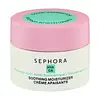What's inside
What's inside
 Key Ingredients
Key Ingredients

 Benefits
Benefits

 Concerns
Concerns

No concerns
 Ingredients Side-by-side
Ingredients Side-by-side

Water
Skin ConditioningC15-19 Alkane
SolventDicaprylyl Ether
EmollientBoron Nitride
AbsorbentPentylene Glycol
Skin ConditioningGlycerin
HumectantPolyglyceryl-3 Distearate
EmulsifyingButyrospermum Parkii Butter
Skin ConditioningSodium Acrylates Copolymer
Glyceryl Stearate
EmollientTribehenin
EmollientOlus Oil
EmollientPotassium Cetyl Phosphate
EmulsifyingPropanediol
SolventCetearyl Alcohol
EmollientLecithin
EmollientCentella Asiatica Extract
CleansingCI 77288
Cosmetic ColorantGlyceryl Stearate Citrate
EmollientCitric Acid
BufferingSodium Hyaluronate
HumectantSodium Phytate
O-Cymen-5-Ol
AntimicrobialSodium Dehydroacetate
PreservativeTocopherol
AntioxidantWater, C15-19 Alkane, Dicaprylyl Ether, Boron Nitride, Pentylene Glycol, Glycerin, Polyglyceryl-3 Distearate, Butyrospermum Parkii Butter, Sodium Acrylates Copolymer, Glyceryl Stearate, Tribehenin, Olus Oil, Potassium Cetyl Phosphate, Propanediol, Cetearyl Alcohol, Lecithin, Centella Asiatica Extract, CI 77288, Glyceryl Stearate Citrate, Citric Acid, Sodium Hyaluronate, Sodium Phytate, O-Cymen-5-Ol, Sodium Dehydroacetate, Tocopherol
Water
Skin ConditioningPropanediol
SolventGlycerin
HumectantEthoxydiglycol
HumectantSodium PCA
HumectantPanthenol
Skin ConditioningAllantoin
Skin ConditioningVinyl Dimethicone/Methicone Silsesquioxane Crosspolymer
Madecassoside
AntioxidantAsiaticoside
AntioxidantPolyacrylate Crosspolymer-6
Emulsion StabilisingSodium Hyaluronate
HumectantXanthan Gum
EmulsifyingLecithin
EmollientSclerotium Gum
Emulsion StabilisingPullulan
Hexanediol
SolventCaprylhydroxamic Acid
Disodium EDTA
Water, Propanediol, Glycerin, Ethoxydiglycol, Sodium PCA, Panthenol, Allantoin, Vinyl Dimethicone/Methicone Silsesquioxane Crosspolymer, Madecassoside, Asiaticoside, Polyacrylate Crosspolymer-6, Sodium Hyaluronate, Xanthan Gum, Lecithin, Sclerotium Gum, Pullulan, Hexanediol, Caprylhydroxamic Acid, Disodium EDTA
 Reviews
Reviews

Ingredients Explained
These ingredients are found in both products.
Ingredients higher up in an ingredient list are typically present in a larger amount.
Glycerin is already naturally found in your skin. It helps moisturize and protect your skin.
A study from 2016 found glycerin to be more effective as a humectant than AHAs and hyaluronic acid.
As a humectant, it helps the skin stay hydrated by pulling moisture to your skin. The low molecular weight of glycerin allows it to pull moisture into the deeper layers of your skin.
Hydrated skin improves your skin barrier; Your skin barrier helps protect against irritants and bacteria.
Glycerin has also been found to have antimicrobial and antiviral properties. Due to these properties, glycerin is often used in wound and burn treatments.
In cosmetics, glycerin is usually derived from plants such as soybean or palm. However, it can also be sourced from animals, such as tallow or animal fat.
This ingredient is organic, colorless, odorless, and non-toxic.
Glycerin is the name for this ingredient in American English. British English uses Glycerol/Glycerine.
Learn more about GlycerinLecithin is a term for a group of substances found in the cell membranes of plants, animals, and humans. They are made up of mixture of phospholipids.
This ingredient has emollient and emulsifying properties.
As an emollient, lecithen helps soften the skin and creates a barrier to keep moisture in.
As an emulsifier, it also helps prevent water and oil ingredients from separating. Lecithin can also help ingredients be better absorbed by the skin.
This is because the phospholipids in lecithin produce liposomes. Liposomes help other ingredients get through the skin barrier.
Depending on the source of this ingredient, lecithin may not be fungal acne safe. This is because some sources of lecithin come from soybean oil, which may feed the malassezia yeast that feeds fungal acne.
We recommend reaching out to the brand you are purchasing from to inquire about the source of their lecithin.
Some other names for this ingredient include soy lecithin and deoiled soy lecithin.
Learn more about LecithinPropanediol is an all-star ingredient. It softens, hydrates, and smooths the skin.
It’s often used to:
Propanediol is not likely to cause sensitivity and considered safe to use. It is derived from corn or petroleum with a clear color and no scent.
Learn more about PropanediolSodium Hyaluronate is hyaluronic acid's salt form. It is commonly derived from the sodium salt of hyaluronic acid.
Like hyaluronic acid, it is great at holding water and acts as a humectant. This makes it a great skin hydrating ingredient.
Sodium Hyaluronate is naturally occurring in our bodies and is mostly found in eye fluid and joints.
These are some other common types of Hyaluronic Acid:
Learn more about Sodium HyaluronateWater. It's the most common cosmetic ingredient of all. You'll usually see it at the top of ingredient lists, meaning that it makes up the largest part of the product.
So why is it so popular? Water most often acts as a solvent - this means that it helps dissolve other ingredients into the formulation.
You'll also recognize water as that liquid we all need to stay alive. If you see this, drink a glass of water. Stay hydrated!
Learn more about Water